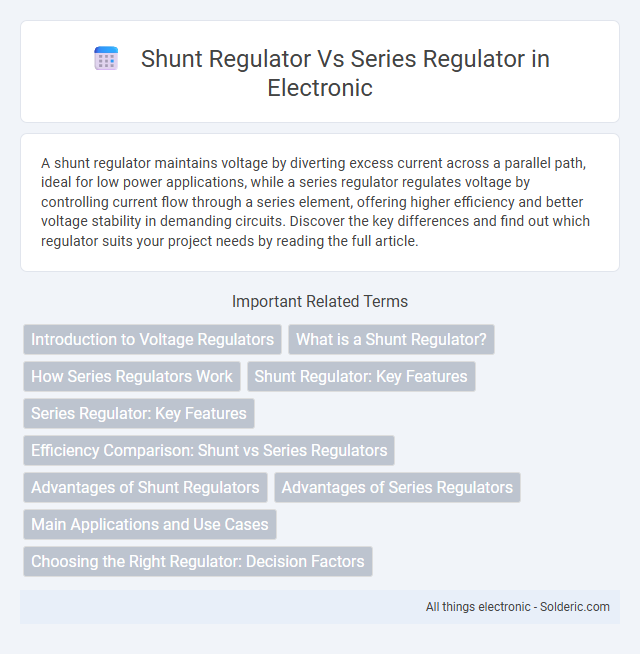A shunt regulator maintains voltage by diverting excess current across a parallel path, ideal for low power applications, while a series regulator regulates voltage by controlling current flow through a series element, offering higher efficiency and better voltage stability in demanding circuits. Discover the key differences and find out which regulator suits your project needs by reading the full article.
Comparison Table
| Feature | Shunt Regulator | Series Regulator |
|---|---|---|
| Operating Principle | Diverts excess current to maintain voltage | Varies series element resistance to regulate voltage |
| Configuration | Parallel to load | In series with load |
| Efficiency | Lower due to continuous current diversion | Higher, less power wasted |
| Output Voltage Stability | Moderate, dependent on load current | High, better load and line regulation |
| Complexity | Simple design | More complex circuitry |
| Typical Applications | Low power, low current precision circuits | High power, wide load range regulators |
| Power Dissipation | High in regulator element | Lower, distributed in series element |
| Cost | Low cost | Higher cost due to complexity |
Introduction to Voltage Regulators
Voltage regulators maintain a stable output voltage despite variations in input voltage or load conditions, ensuring reliable performance in electronic circuits. Shunt regulators control voltage by diverting excess current through a parallel path, making them simple and cost-effective for low-power applications. Series regulators achieve voltage regulation by varying the resistance in series with the load, offering higher efficiency and better regulation for your sensitive electronic devices.
What is a Shunt Regulator?
A shunt regulator controls voltage by diverting current away from the load, maintaining a stable output voltage through a parallel connection with the load. It typically uses a reference voltage and a shunt pass transistor to regulate voltage by adjusting the current flowing into ground. Shunt regulators offer simplicity and fast response but are less efficient compared to series regulators, making them suitable for low-power applications.
How Series Regulators Work
Series regulators maintain a constant output voltage by varying the resistance of a transistor or MOSFET connected in series with the load, effectively controlling the voltage drop. They regulate current flow based on feedback from the output voltage, ensuring stable power despite input fluctuations. Your electronic device benefits from improved efficiency and less heat dissipation compared to shunt regulators.
Shunt Regulator: Key Features
Shunt regulators maintain voltage by diverting excess current through a parallel path, making them ideal for low current applications with simple designs and low cost. They provide fast response to voltage fluctuations but are less efficient due to continuous current flow through the shunt element. Commonly used in voltage reference circuits, shunt regulators excel in noise-sensitive environments where load current remains relatively constant.
Series Regulator: Key Features
Series regulators maintain a constant output voltage by adjusting the resistance in series with the load, providing efficient voltage regulation with low power dissipation. They offer better performance for higher current applications due to their ability to handle larger loads without excessive heat generation. Your choice of a series regulator ensures stable voltage output with improved efficiency compared to shunt regulators, especially in battery-powered or sensitive electronic circuits.
Efficiency Comparison: Shunt vs Series Regulators
Series regulators generally offer higher efficiency than shunt regulators by adjusting the conduction path and dissipating less power as heat. Shunt regulators continuously draw current through a parallel element regardless of load, resulting in increased power loss and lower efficiency. You should choose a series regulator for applications where energy conservation and reduced thermal dissipation are critical.
Advantages of Shunt Regulators
Shunt regulators provide effective voltage stabilization by diverting excess current away from the load, ensuring consistent output voltage under varying load conditions. They offer simplicity in design, low component count, and cost-effectiveness, making them ideal for low-power applications and small circuits. Shunt regulators also have fast response times due to their parallel configuration, which enhances regulation quality during sudden load changes.
Advantages of Series Regulators
Series regulators offer superior voltage regulation and efficiency compared to shunt regulators by controlling the current through a pass transistor connected in series with the load. They provide better load and line regulation, making them ideal for applications requiring stable output voltage under varying load conditions. Series regulators also generate less heat and have higher power efficiency, which improves overall performance in power supply designs.
Main Applications and Use Cases
Shunt regulators are primarily used in low-power voltage reference circuits, such as voltage stabilization for small signal devices and bias supply in transistor circuits, due to their simplicity and fast response to load changes. Series regulators are preferred for higher power applications like power supplies in consumer electronics and industrial equipment because of their superior efficiency and ability to deliver a stable output voltage under varying load conditions. Both regulators serve voltage control functions, but their use cases differ significantly in terms of power handling and load regulation requirements.
Choosing the Right Regulator: Decision Factors
Choosing the right voltage regulator depends on factors such as load current, efficiency, and complexity. Shunt regulators are suitable for low current applications with simple designs and cost efficiency, while series regulators provide better regulation and efficiency for varying loads and higher currents. Your decision should consider the power dissipation, desired output stability, and the specific requirements of your electronic circuit.
shunt regulator vs series regulator Infographic

 solderic.com
solderic.com